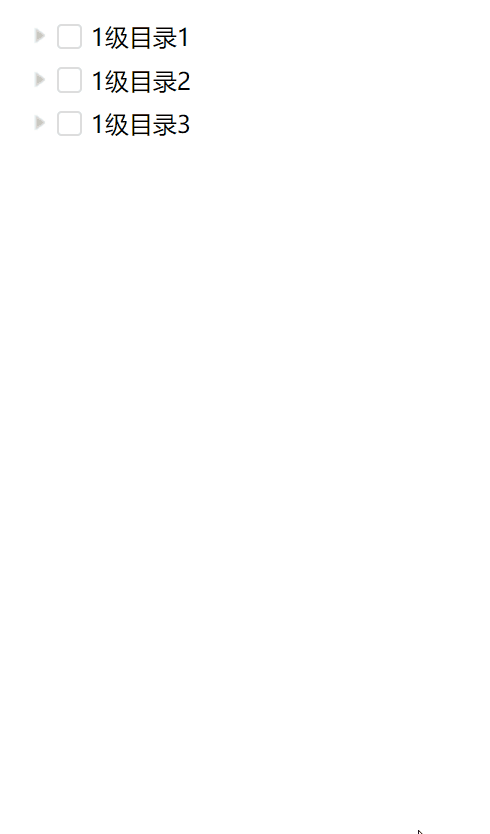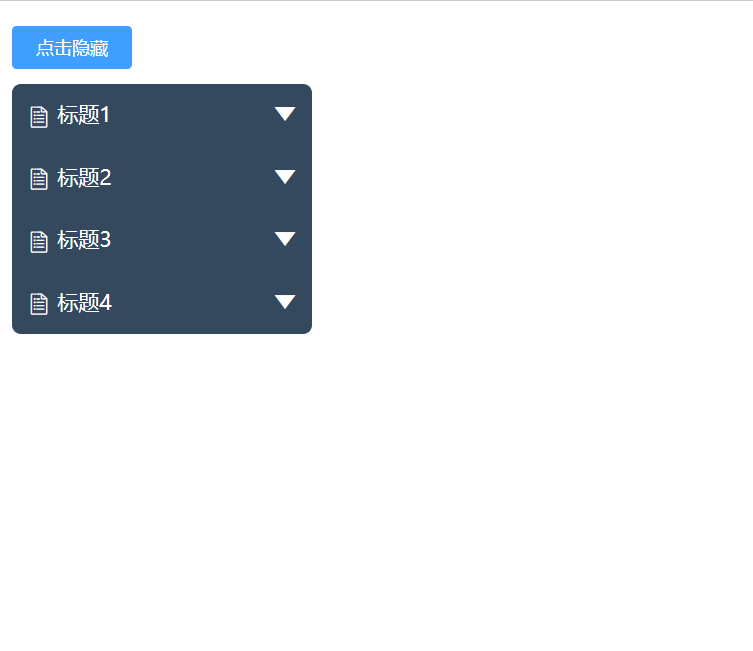您好,登錄后才能下訂單哦!
您好,登錄后才能下訂單哦!
這篇文章主要介紹“怎么使用vue遞歸實現樹形組件”的相關知識,小編通過實際案例向大家展示操作過程,操作方法簡單快捷,實用性強,希望這篇“怎么使用vue遞歸實現樹形組件”文章能幫助大家解決問題。
1. 先來看一下效果:

2. 代碼部分 (myTree.vue)
圖片可以自己引一下自己的圖片,或者使用iconfont的css引入。
<template>
<div class="tree">
<ul class="ul">
<li v-for="(item,index) of treeMenu" :key="index">
<div class="jiantou" @click="changeStatus(index)">
<img src="../../assets/right.png" v-if="!scopesDefault[index]===true && item.children">
<img src="../../assets/down.png" v-if="scopesDefault[index]===true && item.children ">
</div>
<input type="checkbox" @click="checkBox(item)" v-model="item.check">
<span @click="changeStatus(index)">{{item.label}}</span>
<div class="subtree">
<tree-menu :treeMenu='item.children' v-if="scopesDefault[index]" @selectnode = "selectnode"></tree-menu>
</div>
</li>
</ul>
</div>
</template>
<script>
export default{
name:'treeMenu',
props:{
treeMenu:{
type:Array,
default:[]
},
},
data(){
return{
scopesDefault: [],
scopes: [],
node:[],
flatTreeMenu:[],
check:'',
}
},
methods:{
//展開
scope() {
this.treeMenu.forEach((item, index) => {
this.scopesDefault[index] = false
if ('children' in item) {
this.scopes[index] = true
//console.log(item, index)
} else {
this.scopes[index] = false
}
})
},
changeStatus(index) {
if (this.scopesDefault[index] == true) {
this.$set(this.scopesDefault, index, false)
} else {
this.$set(this.scopesDefault, index, this.scopes[index])
}
},
//nodelist 深度優先遞歸
checkBox(node,nodelist=[]){
//console.log("start:",node,nodelist)
if(node!==null){
nodelist.push(node);
if(node.children){
let children=node.children;
for(let i=0;i<children.length;i++){
this.checkBox(children[i],nodelist)//遞歸調用
children[i].check = nodelist[0].check==false?true:false;//選中父節點,子節點全選,取消,子節點取消
}
}
}
this.node=node;
this.check=node.check
},
selectnode(node){
this.$emit("selectnode",node);
}
},
watch:{
node:{
handler(val){
this.selectnode(val);
},
immediate: true
},
check:{
handler(val){
this.selectnode(this.node);
},
immediate: true
}
},
mounted(){
this.scope();
}
}
</script><style lang = "scss" scoped>
.tree{
.ul{
margin: 5px 0 5px 0;
>li{
.jiantou{
display: inline-block;
width: 15px;
>img{
position: relative;
top: 2.0px;
left: 4px;
}
}
.subtree{
margin-left: 20px;
margin-top: 8px;
margin-bottom: 8px;
}
}
}
}
input[type=checkbox]{
visibility: hidden;
cursor: pointer;
position: relative;
width: 15px;
height: 15px;
font-size: 14px;
border: 1px solid #dcdfe6;
background-color: #fff !important;
&::after{
position: absolute;
top: 0;
background-color: #fff;
border: 1px solid #ddd;
color: #000;
width: 15px;
height: 15px;
display: inline-block;
visibility: visible;
padding-left: 0px;
text-align: center;
content: ' ';
border-radius: 3px;
transition: all linear .1s;
}
&:checked::after{
content: "\2713";
font-size: 12px;
background-color: #409eff;
border: 1px solid #409eff;
transition: all linear .1s;
color: #fff;
font-weight: bold;
}
}
.check{
&:checked::after{
content: "--" !important;
}
}
</style>講解:
1、調用組件:
我這用來一個global.js來控制組件的使用(這個js附在文章末尾了),在component文件夾中建立一個myTree文件夾,里面放同名vue文件(myTree.vue),這樣無論在哪里調用這個組件,都可以直接使用<my-tree></my-tree>的方式去調用。
2、組件的方法:
scope():會生成一個數組,里面有根節點是否有子節點,如本代碼里設定的數據,會有scopes=[true,true,true]這樣的結果。changeStatus():每點擊標題或者箭頭,如果當前下標的節點有沒有子節點,再將結果動態賦值給scopesDefault[index],將這個值放于dom上控制開關,遞歸組件。checkBox():在組件內部實現了點擊全選、點擊取消全選的功能,遞歸調用當前方法,將子元素的狀態隨父元素一起變化。selectnode():將當前點擊的node的節點內容上傳到父組件。
3、監聽:
同時監聽:不同節點的切換、同一個節點的是否選中的切換,監聽得到的結果都傳到父組件中。
4、組件遞歸:調用時與父組件相同
3. 使用組件(useMyTree.vue)
<template>
<div class = "loginModuel">
<my-tree :treeMenu='tree' @selectnode="selectnode"></my-tree>
</div>
</template>
<script>
export default{
data(){
return{
msg:"這是登錄頁面",
tree:[
{
id:1,
label:"1級目錄1",
check:false,
children:[
{
id:"1-1",
pid:1,
label:"1.1目錄",
check:false
},
{
id:"1-2",
pid:1,
label:"1.2目錄",
check:false
},
{
id:"1-3",
pid:1,
label:"1.3目錄",
check:false
},
]
},
{
id:2,
label:"1級目錄2",
check:false,
children:[
{
id:"2-1",
label:"2.1目錄",
check:false,
pid:2,
children:[
{
id:"2-1-1",
pid:'2-1',
label:"2.1.1目錄",
check:false,
children:[
{
id:"2-1-1-1",
pid:'2-1-1',
label:"2.1.1.1目錄",
check:false,
children:[
{
id:"2-1-1-1-1",
pid:'2-1-1-1',
label:"2.1.1.1.1目錄",
check:false,
},
{
id:"2-1-1-1-2",
pid:'2-1-1-1',
label:"2.1.1.1.2目錄",
check:false,
},
]
},
]
},
{
id:"2-1-2",
pid:'2-1',
label:"2.1.2目錄",
check:false,
},
{
id:"2-1-3",
pid:'2-1',
label:"2.1.3目錄",
check:false,
},
]
},
{
id:"2-2",
pid:2,
label:"2.2目錄",
check:false
}
]
},//在此繼續添加目錄
{
id:3,
label:"1級目錄3",
check:false,
children:[
{
id:"3-1",
pid:3,
label:"3.1目錄",
check:false,
children:[
{
id:"3-1-1",
pid:"3-1",
label:"3.1.1目錄",
check:false,
children:[
{
id:"3-1-1-1",
pid:"3-1-1",
label:"3.1.1.1目錄",
check:false,
children:[
{
id:"3-1-1-1-1",
pid:"3-1-1-1",
label:"3.1.1.1.1目錄",
check:false
},
]
},
]
},
]
}
]
},
],
plist:[],//此級以上所有父節點列表
flatTree:[],//tree的平行數據
node:'',//當前點擊的node,
}
},
methods:{
//將tree樹形數據轉換為平行數據
transformData(tree){
tree.forEach(item=>{
this.flatTree.push(item);
item.children && item.children.length>0 ? this.transformData(item.children) : ""
})
},
//子組件傳遞過來的點擊的node的值
selectnode(node){
this.node=node;
this.flatTree=[];
this.transformData(this.tree);
if(node.check==false){//這個節點已經被選中,正在點擊取消選中
this.plist=[];//每次點擊一個新的節點都將原來plist的內容清空
this.getParentnode(this.flatTree,node.pid)
}else{//正在選中
this.childAllToParent(node,this.flatTree,1);
}
},
//子節點取消選中,拿到此子節點所有的父節點plist
getParentnode(tree,pid){
//this.plist=[]
if(pid!==null){
tree.forEach(item=>{
if(item.id==pid){
this.plist.push(item)
this.getParentnode(this.flatTree,item.pid)
}
})
}
if(!pid){
this.plist.forEach(item=>{
this.updateParentCheck(this.tree,item)
})
}
},
//將原數據tree對應id的項的check值改為false
updateParentCheck(tree,plistItem){
//console.log("方法updateParentCheck接收的plistItem參數:",plistItem)
tree.forEach(item=>{
if(item.id==plistItem.id){
item.check=false;
}
if(item.id!==plistItem.id && item.children){
this.updateParentCheck(item.children,plistItem)
}
})
},
//子節點全部選中后父節點選中
childAllToParent(node,flatTree,j){
let fatherNode='';
let brotherNode=[];
this.flatTree.forEach(item=>{
if(node.pid && node.pid==item.id){
fatherNode=item;//找到了父節點--用于改變check的值
}
})
//判斷該結點所有的兄弟節點是否全部選中
flatTree.forEach(item=>{
if(item.pid && node.pid && item.pid==node.pid){
brotherNode.push(item)//找到所有的兄弟節點
}
})
//i為被選中的兄弟節點的個數
let i=0;
this.flatTree.forEach(item=>{
if(node.pid==item.pid && item.check==true){
i=i+1;
}
})
//修改父節點的選中值
if(i==brotherNode.length && fatherNode){
fatherNode.check=true
}
// console.log(`第j次遞歸 j=${j}`)
// console.log(`選中的bro=${i},brother的個數:${brotherNode.length}`)
// console.log("父節點:",fatherNode,"兄弟節點",brotherNode)
if(fatherNode.pid!==undefined){
j=j+1;
this.childAllToParent(fatherNode,this.flatTree,j)
}
}
},
mounted(){
this.transformData(this.tree);//數據初始化:將tree樹形數據轉換為平行數據
//console.log(this.flatTree)
}
}
</script><style lang = "scss" scoped>
.loginModuel{
margin-left: 400px;
margin-top: 100px;
.tree{
.ul{
>li{
margin: 5px 0 5px 0;
>img{
position: relative;
top: 2.4px;
left: 4px;
}
}
.ul2{
>li{
position: relative;
left: 20px;
margin: 5px 0 5px 0;
>img{
//transition: all ease-in-out 1s;
position: relative;
top: 2.4px;
left: 4px;
}
}
}
}
}
}
input[type=checkbox]{
cursor: pointer;
position: relative;
width: 15px;
height: 15px;
font-size: 14px;
border: 1px solid #dcdfe6;
background-color: #fff !important;
&::after{
position: absolute;
top: 0;
background-color: #fff;
border: 1px solid #ddd;
color: #000;
width: 15px;
height: 15px;
display: inline-block;
visibility: visible;
padding-left: 0px;
text-align: center;
content: ' ';
border-radius: 3px;
transition: all linear .1s;
}
&:checked::after{
content: "?";
font-size: 12px;
background-color: #409eff;
border: 1px solid #409eff;
transition: all linear .1s;
color: #fff;
font-weight: bold;
}
}
</style>子組件主要是實現全選和取消全選。由于遞歸組件的原因,子組件拿不到完整的數據,所以接下來的兩個功能:全選后某一個子節點取消選中則父節點取消選中、子節點全選后父節點自覺選中的功能就要在父組件中完成了。
講解:
1、設值:
樹形數據必須有pid屬性,用于向上遍歷。
2、方法:
transformData():將層級數據轉為平行數據,避免后期不停的遞歸調用消耗時間,平級數據使用一般的循環即可完成。selectnode():由子組件傳遞過來的方法,大致分為兩個方向:選中、取消選中。選中時實現功能一:子節點全選后父節點自覺選中;取消選中實現功能二:全選后某一個子節點取消選中則父節點取消選中。getParentnode():用于實現功能二。子節點取消選中后,根據pid,將在它上面級別的所有父節點列表拿到,再由方法updateParentCheck()將父節點的check值全部改為false。childAllToParent():用于實現功能一。遞歸調用該方法,將操作節點的父節點拿到,根據兄弟節點有相同的pid,拿到兄弟節點的個數,如果兄弟節點中被選中的個數等于兄弟節點的個數,則修改父節點的check值為true,直到到了根節點結束遞歸。
這個組件實現起來不是很難,只要是心細就能很好的完成。
如果后期需要使用某些數據的話,直接掛到data里就可以。
如果有更好的方法或者存在某些疑問,歡迎小伙伴留言!
附: (global.js => 放于component文件夾下)
import Vue from 'vue';
function capitalizeFirstLetter(string){
return string.charAt(0).toUpperCase() + string.slice(1);
}
const requireComponent = require.context(
'.',true,/\.vue$/
//找到components文件夾下以.vue命名的文件
)
requireComponent.keys().forEach(fileName => {
const componetConfig = requireComponent(fileName);
let a = fileName.lastIndexOf('/');
fileName = '.' + fileName.slice(a);
const componetName = capitalizeFirstLetter(
fileName.replace(/^\.\//,'').replace(/\.\w+$/,'')
)
Vue.component(componetName,componetConfig.default || componetConfig)
})由此其實可以實現很多遞歸組件,如側邊欄。
下面我放一個自己寫的側邊欄的動圖,方法比這個樹形組件要簡單些,畢竟不用考慮復選框的值。感興趣的小伙伴們可以試著實踐一下

關于“怎么使用vue遞歸實現樹形組件”的內容就介紹到這里了,感謝大家的閱讀。如果想了解更多行業相關的知識,可以關注億速云行業資訊頻道,小編每天都會為大家更新不同的知識點。
免責聲明:本站發布的內容(圖片、視頻和文字)以原創、轉載和分享為主,文章觀點不代表本網站立場,如果涉及侵權請聯系站長郵箱:is@yisu.com進行舉報,并提供相關證據,一經查實,將立刻刪除涉嫌侵權內容。